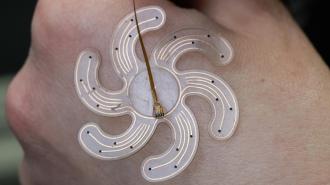A soft brain implant that unfurls under the skull could give doctors a less invasive way to monitor patients’ brain activity — and maybe allow people to directly control technology with their minds.
The challenge: Placing an electrode array on the surface of the brain allows scientists to see neural activity in far more detail than is possible with electrodes outside of the skull.
Known as “electrocorticography,” this technology was initially developed to treat people with epilepsy, but it’s also been used in research for other types of neurological disorders and in the development of brain-computer interfaces.
A limitation of the technique, though, is the need for patients to undergo invasive surgeries during which their skull is opened up so the array can be implanted. The larger the array, the better the data collection — but the more invasive and risky the surgery.
“We think this is a technology that could be deployed widely at the clinic.”
Stephanie Lacour
What’s new? Researchers at the Swiss Federal Institute of Technology Lausanne (EPFL) have now developed an electrode-covered soft brain implant that can be inserted through a 2-centimeter hole in the skull and then expanded to cover an area 4 centimeters wide.
“This is to answer a specific request from neurosurgeons who are hoping to have minimally invasive devices, so they can have — through a small hole in the skull — a large area of coverage of the surface of the brain,” said lead researcher Stephanie Lacour.
“We think this is a technology that could be deployed widely at the clinic,” she added.
How it works: EPFL’s soft brain implant looks like a flat, clear piece of rubber, with six arms spiraling away from a central circle. Thin electrodes made of gold extend along each arm and around the perimeter of the device.
The thin implant consists of two layers, connected only at the edges. This means each arm can be inverted and tucked away inside the circle — like pushing the tips of the fingers of a rubber glove inward until they’re hidden inside its palm.
Once inverted, the implant is placed into a tube called the “loader,” which can be inserted through a two-centimeter hole in the skull. A liquid is then pumped into the implant, which forces the inverted arms to expand outward, one at a time, into the 1-millimeter gap between the brain and the skull.
“We had to come up with a deployment system that would be gentle enough not to compress or damage the underlying brain, and strong enough to sustain the deployment in this narrow space,” said Lacour.
Looking ahead: We don’t know how well this soft brain implant actually works — so far, it has only been tested in a model of the human head and a mini pig. The EPFL team is currently working to add more electrodes to the tech and scale it for use in clinical trials.
If everything goes well, the team is hopeful their soft implant could increase the deployment of brain-computer interfaces, which can be used to control prosthetics, reverse paralysis, and — maybe, one day — allow us to merge with AI and supercharge our intelligence.
“A minimally invasive implant will increases [sic] adoption by clinicians and patients, and presents numerous benefits such as reduced surgical cost, reduced patient recovery time, and reduced infection risk,” said Nicolas Vachicouras, CEO and co-founder of Neurosoft Bioelectronics, an EPFL spinout helping get the tech into clinics.
We’d love to hear from you! If you have a comment about this article or if you have a tip for a future Freethink story, please email us at tips@freethink.com.
